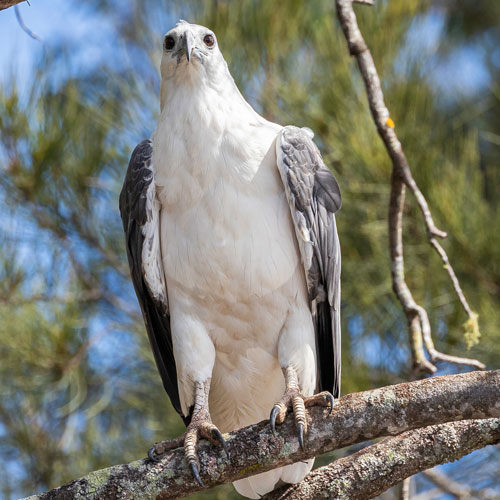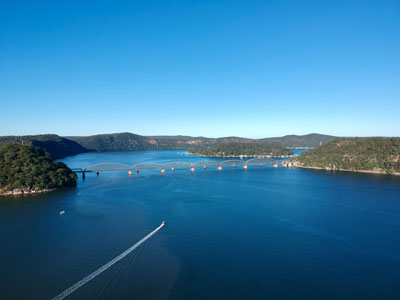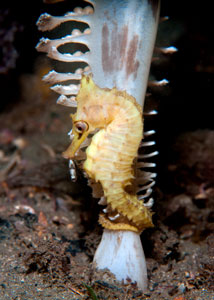
An estuary is a body of water where freshwater from rivers and streams meets and mixes with saltwater from the ocean. Estuaries are typically characterized by dynamic tidal flows, fluctuating salinity levels, and diverse ecosystems. They are complex environments, known for their high biodiversity, offering a variety of environments and habitats that support a large number of plants and animals.
Here in Hornsby Shire, our northern boundary is defined by one of the most significant estuaries on the Australian eastern seaboard —The Hawkesbury River (or Deerubbin). The Hawkesbury River is home to a brilliant diversity of native animals, as this winding body of water links inland animals like Wedge-Tailed Eagles (Aquila audax) with unique marine taxa like White’s Seahorse (Hippocampus whitei) and iconic coastal fauna like the White-Bellied Sea Eagle (Haliaeetus leucogaster).
Residents of Hornsby Shire play a crucial role in the stewardship of Deerubbin, the protection of its unique ecosystems and ensuring that this natural marvel remains a thriving environment and enjoyable destination for the generations to come.
The role of the Hawkesbury estuary
Estuaries are a great place to spend time swimming, fishing, walking, canoeing or having a picnic. Importantly, they also play a crucial ecological role in filtering pollutants from runoff before they reach the ocean and in mitigating the impacts of coastal storms by absorbing and dissipating wave energy. They serve as important habitats, acting as nurseries for fish, shelter for wildlife and providing vital feeding grounds for migratory birds.
The Hawkesbury River is downstream from your local stormwater drain
To help protect your local creek and our beautiful Hawkesbury river, it’s important to consider how our everyday activities can contribute to stormwater pollution. Actions like washing your car on the street, blowing lawn clippings down the drain or not having adequate erosion and sediment control can harm water quality and disrupt the natural flow of local waterways. By adopting best practices, you can minimise your impact and help preserve the water quality and ecosystems of the Hawkesbury River.
The connection between an estuary and its catchment is vital for understanding how water runoff impacts an estuarine system. Here are some key concepts in understanding how water from your drain winds up in our rivers and oceans:
Catchment Area: The catchment encompasses the entire land area drained by rivers, streams, and other water bodies that ultimately flow into the estuary. Rainwater and runoff are collected within this area and travel through various channels, tributaries, and groundwater systems before reaching the estuary.
Water Flow: Water in the catchment area flows downhill due to gravity, following the natural topography of the land. As it moves, it picks up sediment, nutrients, and pollutants from the landscape.
Convergence in the Estuary: Water from any part of the catchment area eventually converges and flows into the estuary. Smaller streams and rivers merge into larger ones, forming a network of waterways that discharge into the estuary.
Estuary as Receiving Waters: The estuary acts as the receiving waters for the flow from the catchment area. It is the endpoint of the hydrological cycle for a particular catchment. Here, freshwater from rivers and streams meets saltwater from the ocean, creating a unique and dynamic environment characterized by fluctuating salinity levels and diverse ecosystems.
What you can do for the Hawkesbury River
The health of estuaries depends on responsible catchment management. By safeguarding catchment areas, we can preserve these vital ecosystems and maintain their ecological balance.
So what can you do?
- Prevent pollution: Ensure pollutants do not enter waterways via stormwater drains or littering. Remember, only rain should go down the drain.
- Protect riparian vegetation: Avoid removing creek-side vegetation or ground cover. Natural vegetation helps prevent soil erosion. Its removal due to development or land clearing affects water flow and quality, leading to issues like turbidity, algal blooms, and the smothering of sensitive environments like wetlands and seagrass beds.
- Reduce hard surfaces: When developing land or upgrading your home, minimise impervious surfaces like roads, pavements, and roofs but aim to increase natural ground cover by planting native plants. This allows water to slowly infiltrate the ground, reducing downstream erosion and flooding.
- Preserve habitats: Protect vegetation and keep fallen logs to provide habitat for unique plants and animals. Also, reduce the number of weeds on your property.
- The health of estuaries relies on responsible catchment management. Pollution, sedimentation, and changes to natural water flow can profoundly impact the estuarine environment and its dependent species. By protecting catchment areas, we can preserve these vital ecosystems and maintain their ecological balance. Your help is essential in achieving this goal.
The health of estuaries relies on responsible catchment management. Pollution, sedimentation, and changes to natural water flow can profoundly impact the estuarine environment and its dependent species. By protecting catchment areas, we can preserve these vital ecosystems and maintain their ecological balance. Your help is essential in achieving this goal.
Hornsby Shire Council is one of six councils collaborating on the Hawkesbury-Nepean River System Coastal Management Plan. This initiative, a partnership between local and state government agencies, aims to support the coordinated management and sustainable development of the Hawkesbury-Nepean River system for the benefit of nature, the economy, and the community. Learn more about the project here.


Image credit: Juan Esquivel Muelbert (left) Dr David Harasti (right).







